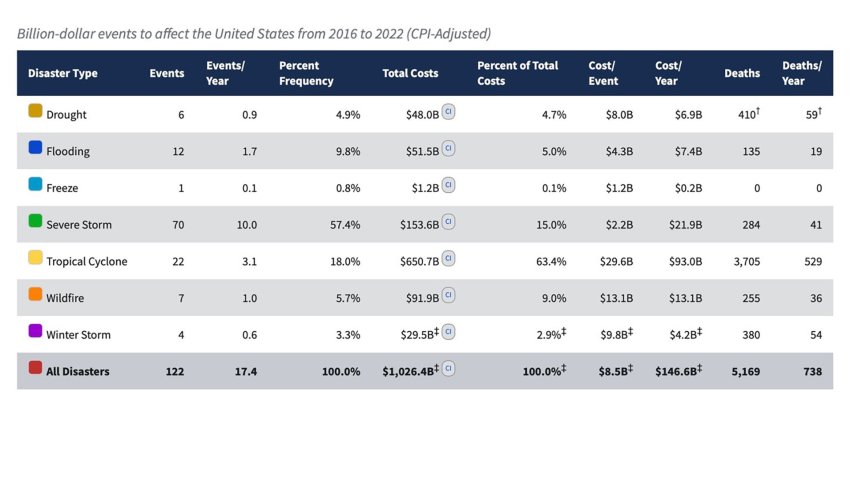
Last week, the National Oceanic and Atmospheric Administration reported the US surpassed $1 trillion in losses and 5,000 deaths from 122 separate billion-dollar disasters over the past seven years. These eyewatering losses demonstrate the need to redouble our collective efforts to reduce disaster impacts. The Federal Emergency Management Agency (FEMA) has the opportunity to help transform communities toward a position of proactive disaster #resilience rather than reactive response. It can do so by leveraging its new statutory authorities.
FEMA currently encourages communities to invest in resilience through its signature resilience grant program, Building Resilient Infrastructure and Communities (BRIC). This year FEMA is making available $2.3 billion for hazard mitigation projects through the BRIC program. This will pay dividends to the communities receiving the grants and federal taxpayers because $1 invested in hazard mitigation saves $6 when a disaster occurs.
FEMA now has the opportunity to build upon the foundation laid by the BRIC program thanks to two recent changes to the nation's disaster management law, the Stafford Act. With these recent amendments, FEMA could further incentivize resilience investments through the BRIC program and FEMA's traditional disaster recovery programs.
Community Disaster Resilience Zones
Last month President Biden signed the Community Disaster Resilience Zones (CDRZ) Act of 2022 into law. The Act amends the Stafford Act to reduce the barriers to entry for vulnerable communities to apply for BRIC grants. FEMA is directed to designate communities most in need of hazard mitigation assistance, as identified by a risk analysis tool that considers such factors as social vulnerability, natural hazards loss exposures, and lack of resilience.
CDRZ-designated communities would then be eligible for an increased federal share for BRIC grants, up to 90% (from the current 75%). This should encourage those communities unable to afford the previous 25% State/local match to apply for funding that they would have otherwise not pursued.
FEMA Public Assistance incentive measures
Another provision authorizes FEMA to increase the federal cost share for communities that have experienced presidentially declared disasters. The Disaster Recovery Reform Act of 2018 proposed and the Bipartisan Budget Act of 2018 authorized FEMA to incentivize communities to take proactive steps before a disaster by increasing federal funding available after a disaster.
Section 406(b) of the Stafford Act now states:
(3) INCREASED FEDERAL SHARE.—
(A) INCENTIVE MEASURES.— The President may provide incentives to a State or Tribal government to invest in measures that increase readiness for, and resilience from, a major disaster by recognizing such investments through a sliding scale that increases the minimum Federal share to 85 percent. Such measures may include—
(i) the adoption of a mitigation plan approved under section 322;
(ii) investments in disaster relief, insurance, and emergency management programs;
(iii) encouraging the adoption and enforcement of the latest published editions of relevant consensus-based codes, specifications, and standards that incorporate the latest hazard-resistant designs and establish minimum acceptable criteria for the design, construction, and maintenance of residential structures and facilities that may be eligible for assistance under this Act for the purpose of protecting the health, safety, and general welfare of the buildings' users against disasters;
(iv) facilitating participation in the community rating system; and
(v) funding mitigation projects or granting tax incentives for projects that reduce risk.
By raising the federal cost share for FEMA Public Assistance from 75% to up to 85%, a community that took these proactive steps could receive millions more in post-disaster funding. And these commonsense resilience measures—mitigation plans, insurance, emergency management programs, building codes, risk ratings, State/local mitigation funding and tax incentives—reduce financial losses and human suffering, and get communities up and running faster after a disaster.
While this additional funding would only materialize if a disaster hit a community, it provides a strong incentive for all communities to invest in resilience because they would be confident that FEMA would recognize and reward these investments.
Private Sector incentives
And, of course, FEMA, and federal funding more generally, is only one piece of the resilience puzzle. The private sector, too, has levers it can and should pull to incentive resilience. Indeed, this is a focus of a study on resilience incentives we are undertaking at the National Institute of Building Sciences.
We are engaging finance, insurance, and real estate stakeholders to align incentives among these industries as co-beneficiaries of resilience investments. These private sector efforts have the potential to amplify the government's resilience efforts and scale societal benefits.
Conclusion
By leveraging its new statutory authorities for resilience, FEMA has the opportunity to:
- Set an example for other government agencies and the private sector
- Reduce disaster suffering
- Save billions for disaster survivors and taxpayers
That's a win, win, win.
(Graphic credit: NOAA National Centers for Environmental Information (NCEI) U.S. Billion-Dollar Weather and Climate Disasters (2023). https://www.ncei.noaa.gov/access/billions/summary-stats/US/2016-2022)




